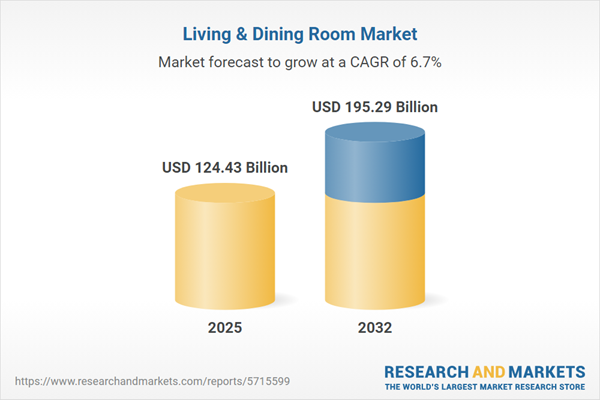Speak directly to the analyst to clarify any post sales queries you may have.
The living and dining room market is undergoing rapid transformation as organizations pursue more adaptive, sustainable, and technology-driven interior environments. Senior leaders aiming to secure long-term growth must anticipate evolving client preferences and navigate an increasingly complex landscape shaped by changing regulations and innovation imperatives.
Market Snapshot: Living & Dining Room Market
The global living and dining room market is projected to grow from USD 116.65 billion in 2024 to USD 124.43 billion in 2025, ultimately reaching USD 195.29 billion by 2032, with a robust CAGR of 6.65%. Fueling this expansion are both commercial and residential demand, digital integration in sales, and a rising appetite for customizable and multifunctional product solutions. Organizations are reconfiguring value propositions, leveraging advanced sales channels, and focusing on customer diversity to build stronger positions in existing and developing territories.
Scope & Segmentation in the Living & Dining Room Market
Strategic engagement within this sector depends on comprehensive insights into regional trends, procurement drivers, and evolving design expectations. Key segmentation areas and categories include:
- Product Types: Armchairs, bar stools, side chairs, extendable and fixed tables, console sideboards, loveseats, sectional sofas, and sofa beds—each supporting versatile applications in commercial office fit-outs, hospitality projects, and residential interior upgrades.
- Distribution Channels: Mass merchants, showrooms, specialty stores, direct-to-consumer formats, and major e-commerce platforms enable organizations to implement omnichannel strategies and connect with both professional buyers and end-users.
- Material Types: Glass, metal, plastic, various upholstered finishes, and wood selections are evaluated for durability, life-cycle cost, safety, and compliance to align with institutional standards and environmental goals.
- Style Options: Industrial, modern, contemporary, minimalist, Scandinavian, traditional, classic, vintage, and transitional aesthetics support tailored solutions that reflect global and local design trends for a diverse end-user base.
- Regional Segments: Americas, Europe, Middle East, Africa, and Asia-Pacific regions each present distinct adoption rates for digital channels, unique regulatory challenges, and region-specific opportunities for sustainable growth.
- Leading Companies Monitored: Ingka Holding B.V., Wayfair Inc., Williams-Sonoma, Ashley Furniture Industries, RH, La-Z-Boy, Ethan Allen Interiors, Haverty Furniture Companies, Flexsteel Industries, Natuzzi. These organizations serve as benchmarks for product innovation, distribution efficiency, and compliance across the global value chain.
Key Takeaways for Decision-Makers
- Prioritize modular and multi-purpose furniture offerings to improve space efficiency and easily adjust interiors to shifting organizational needs.
- Leverage advanced features, such as integrated smart technology and wireless capabilities, to modernize spaces and streamline collaboration and daily operations.
- Commit to sourcing sustainable materials and embedding ESG frameworks to enhance brand perception and strengthen supply chain transparency.
- Expand omnichannel and direct-to-consumer strategies to support varied procurement models and improve market accessibility across different buyer segments.
- Customize inventory and product specifications for regional markets to secure regulatory alignment and build robust local relationships with stakeholders.
- Collaborate with relevant partners in design and technology to accelerate development cycles and ensure ongoing compliance with evolving sector requirements.
Tariff Impact: Navigating Policy-Driven Disruption
Policy shifts impacting tariffs on hardwoods, metals, and assembly components in the United States are prompting organizations to rethink manufacturing and sourcing. Businesses are responding by increasing nearshoring, investing in automation, and selecting materials with lower regulatory risk, such as those that are recyclable or responsibly sourced. These approaches are designed to shield supply chains from unforeseen disruptions and to maintain competitiveness without reducing innovation capacity.
Methodology & Data Sources
This analysis combines insights from executive-level interviews across manufacturing, logistics, and retail sectors with secondary research on design evolution and policy changes. Academic scrutiny ensures the findings remain applicable and actionable for senior leadership teams seeking strategic clarity.
Why This Report Matters for Senior Leaders
- Delivers actionable benchmarks and strategic insights, equipping organizations to build forward-thinking growth plans in the living and dining room market.
- Clarifies how digital transformation and new ESG mandates influence operations and competitive standing, especially amid evolving procurement practices.
- Enables leadership to manage risk, adjust investment priorities, and respond proactively to shifting regulations and client expectations.
Conclusion
This report empowers decision-makers with practical intelligence to navigate transition and drive long-term value. By leveraging timely insights, organizations can adapt effectively in an ever-changing living and dining room market landscape.
Additional Product Information:
- Purchase of this report includes 1 year online access with quarterly updates.
- This report can be updated on request. Please contact our Customer Experience team using the Ask a Question widget on our website.
Table of Contents
3. Executive Summary
4. Market Overview
7. Cumulative Impact of Artificial Intelligence 2025
Companies Mentioned
The companies profiled in this Living & Dining Room market report include:- Ingka Holding B.V.
- Wayfair Inc.
- Williams-Sonoma, Inc.
- Ashley Furniture Industries, LLC
- RH, Inc.
- La-Z-Boy Incorporated
- Ethan Allen Interiors Inc.
- Haverty Furniture Companies, Inc.
- Flexsteel Industries, Inc.
- Natuzzi S.p.A.
Table Information
| Report Attribute | Details |
|---|---|
| No. of Pages | 186 |
| Published | October 2025 |
| Forecast Period | 2025 - 2032 |
| Estimated Market Value ( USD | $ 124.43 Billion |
| Forecasted Market Value ( USD | $ 195.29 Billion |
| Compound Annual Growth Rate | 6.6% |
| Regions Covered | Global |
| No. of Companies Mentioned | 11 |









